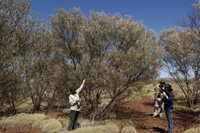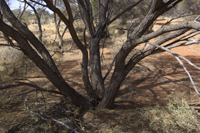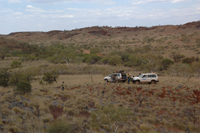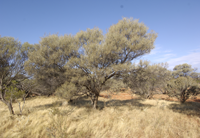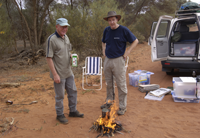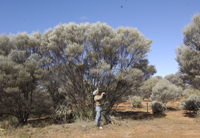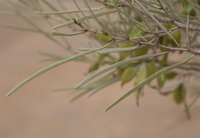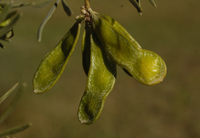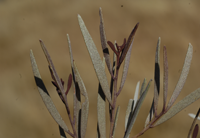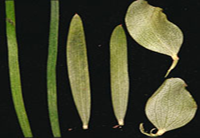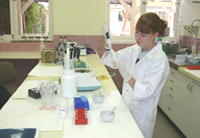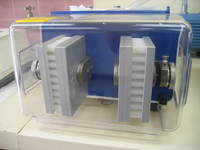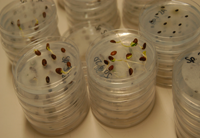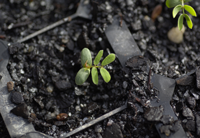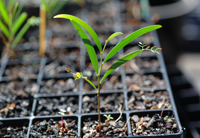Field Study 2007/2008
In 2007/2008 comprehensive field studies were conducted in the Yalgoo, Murchison/Ashburton, Gascoyne and Pilbara regions of Western Australia, as well as short field excursions in the Northern Territory and South Australia. This work involved staff and volunteers from the Department of Environment and Conservation (DEC) and staff from the Centre for Plant Biodiversity Research (CSIRO), the Alice Springs Herbarium (NT) and the State Herbarium of South Australia (AD). The aims of this work were to recollect critical material identified as a result of the 2006/2007 herbarium and genetic study, target new areas in an attempt to encompass as much of the diversity of Mulga in W.A. as possible, collect material from the type localities of Acacia aneura var. intermedia (N.T.) and most importantly of Acacia aneura (S.A.), both critical to the Understanding Mulga study, and collect seed for further ontogenetic work.
-
1st October to 30th October 2007: Mullewa - Gascoyne Junction - Mt Augustus - Paraburdoo - Tom Price - Newman - West Angelas - Meekatharra - Wiluna - Lorna Glen Station - Leonora - Laverton - Sandstone - Mt Magnet. Trip participants: Bruce Maslin & Jordan Reid (DEC), Joe Miller (CSIRO) and Daphne Edinger & Gilbert Marsh (DEC volunteers).
-
21st September to 27th September 2008: Northern Territory. Trip participants: Bruce Maslin & Jordan Reid (DEC), Joe Miller (CSIRO) and David Albrecht & Peter Latz (NT).
- 28th September to 2nd October 2008: South Australia. Trip participants: Bruce Maslin & Jordan Reid (DEC), Joe Miller (CSIRO) and Martin O'Leary (AD).
-
8th October to 27th October 2008: Mt Augustus - Meekatharra - Cue - Mt Magnet - Leonora/Laverton - Menzies - Sandstone - Paynes Find. Trip participants: Bruce Maslin, Jordan Reid, Meriel Falcolner & Sue Carroll (DEC) and Daphne Edinger & Gilbert Marsh (DEC volunteers).
- 10th November to 13 November 2008: Paynes Find - Sandstone - Mt Magnet. Trip participant: Bruce Maslin.
567 herbarium collections of Mulga were gathered during these trip (B.R. Maslin 9129-9401, 9497-9794, 9895-9943) and are now lodged at the Western Australian Herbarium (PERTH); over 1180 samples for genetic study were collected (1113 from W.A. taxa and 72 from N.T./S.A. taxa) and 80 seed lots were gathered for ontogenetic study.
Field Study 2006/2007
In 2006 three Mulga field studies were conducted in the Murchison/Ashburton and northeastern Goldfields regions of Western Australia. This work involved staff from the Department of Environment and Conservation (DEC) and the University of Iowa (IOWA). The aims of this work were to gather material for taxonomic and genetic study, and seed for germination trials.
-
31st August to 13th September 2006: Paynes Find - Yalgoo – Mt Magnet – Sandstone – Leinster – Wiluna – Meekatharra – Mt Gould. Trip participants: Bruce Maslin & Richard Fairman (DEC) and Joe Miller (IOWA).
-
4th of October to 13th of October 2006: Paynes Find - Yalgoo – Mt Magnet – Meekatharra – Mt Gould – Wiluna – Leinster – Sandstone. Trip participant: Richard Fairman (DEC)
-
30th of October to 5th of November 2006: Paynes Find – Yalgoo – Mt Magnet – Sandstone. Trip participant: Richard Fairman (DEC)
339 herbarium collections of Mulga were gathered during these trips (B.R. Maslin 8907 - 9112; R. Fairman 218 - 352) and are now lodged at the Western Australian Herbarium (PERTH); 457 samples for genetic study were collected (see below); 120 seed lots were gathered for ontogenetic study. The field program targeted both monotypic and mixed stands of Mulga and most of the plants collected have been tagged should they need to be re- sampled for further studies.
Taxonomic Study 2007/2008
Morphological analysis of variation of herbarium material has been undertaken using conventional taxonomic methodolgy; this is an ongoing process. This analysis has revealed two important taxonomic characters for aid in defining different Mulga taxa, namely branchlet resin type and pod wing type. Using this character combination a broad conceptual framework for understanding variation in W.A. Mulga has been established and consequently three major Mulga Alliances (Green, Grey-green and Blue) have now been recognized to accomodate the more than 20 Mulga taxa that we identify. Other taxonomic characters which have proved useful in defining Mulga taxa include: new shoot colour, resinosity and indumentums; phyllode shape, size, colour, curvature and cross-section and pod shape & size. A detailed examination of Mulga flowers and seeds has not yet been undertaken.
Draft descriptions have been prepared of the provisional Mulga taxa that are currently recognized, however, further definition and verification of the these entities will be needed for this work to continue. A key to these groups (using Lucid software) is currently under construction, while images and other information concerning the taxa is being assembled.
The existence of numerous hybrids within the Mulga group has proved a complicating factor. Although several taxonomic characters are useful in identifying hybrids, further work on this subject is required.
Taxonomic Study 2006/2007
Specimens collected in 2006 (see above) and by Maslin and Miller (from the Pilbara in 2000, and the Ashburton district in 1999) have been critically examined and a number of provisional taxonomic groups have been identified. Once verified these groups will form the basis for all future taxonomic, genetic and other analyses. A key to these groups (using Lucid software) is currently under construction.
This preliminary taxonomic investigation has revealed/confirmed that the following morphological attributes are important in defining Mulga taxa: plant growth form, phyllode shape, length, width and colour; pod nervature, indumentum and presence/absence of a marginal “wing”.
Genetic Study 2007/2008
DNA has been extracted from approximately 840 samples (which were collected during the 2007 field study) in Perth and sent to Miller at the Centre of Plant Biodiversity, Canberra for analysis. Of the 344 genetic samples collected during 2008, 272 will be extracted in Perth and the DNA sent to Miller; the remaining 72 samples have been extracted by Miller. In addition to the four microsatellite markers identified from the earlier constructed libraries and used to generate data, another eight markers have been selected based on their ability to genetically differentiate individual plants or species. Currently data is being generated using these 12 microsatellite markers. Also a subset of 120 plants have been analyzed using five microsatellite markers. These plants used have been specifically chosen to cover the entire range of morphological variation within W.A. Mulga and are identified as being critical to identification of taxa within Mulga.
The chloroplast DNA sequence data has been expanded to include five chloroplast genes and these data have been generated in over 150 plants (essentially the same plant subset used in the microsatellite dataset). Specific DNA differences are now known and can be used to assign a plant to a taxonomic grouping.
Flow cytometry analysis was undertaken in Iowa on seedlings from previous field collections. With data generated from this analysis we have adjusted our data analysis to account for this important information. Presently we do not have access to a flow cytometer and further research in this area will depend on the successful application of a CSIRO equipment grant proposal to be submitted by Miller.
Genetic Study 2006/2007
DNA has been extracted from approximately 700 samples, these include 400 samples collected during the 2006 field study that were extracted in W.A. and sent to Miller at the University of Iowa. In Iowa DNA was extracted from W.A. Mulga samples collected in 1999 and 2000 (prior to the Understanding Mulga project commencing). This included 200 DNA samples from stored phyllodes and 100 DNA extractions from seedlings derived from seeds collected on these previous trips. Microsatellite libraries have been constructed by Byrne and Miller. The libraries have been tested and 16 loci were developed. Currently data is being generated on four of the microsatellite loci for the 700 samples and after analysis further microsatellite data will be generated as needed.
Sequence data of the chloroplast psbA-trnH intergenic spacer region has been generated for over 100 collections. These aligned sequences have been analyzed and will compared to the taxonomic findings.
A flow cytometry instrument for measuring, among other things, DNA content was recently purchased by Miller (not using Understanding Mulga funds). This will enable the crucial estimates of ploidy levels to be made, complementing the microsatellite work on future collections. Microsatellite and chloroplast DNA data generation will continue on the 2006 collections as well as the older collections. The integration of DNA ploidy analysis will be integrated where possible into the project. The first chloroplast DNA results have been generated but not yet correlated with the taxonomic findings.
Ontogenetic Study 2007/2008
Subsets of seedlings germinated during 2006/2007 have been destructively samples for herbarium vouchers (lodged at the Western Australian Herbarium) or planted out in a dedicated plot at the Field Trial Area of the Department of Environmental Biology at Curtin University of Technology (see acknowledgements below). Preliminary analysis of seedling data testing for neoteny suggestes that this phenomenon is most likely not present within entities of the Green and Grey-gree Mulga alliances, but is unable to be assessed within the the Blue alliance of Mulga due to low numbers of seed collections and seedling mortality. Field studies during 2007/2008 focused seed collections on Blue alliance entities and other poorly or uncollected Mulga morphotypes. These collections have now been stored and will be prepared and germinated as required during 2009.
Ontogenetic Study 2006/2007
In order to observe plant growth development and obtain taxonomically useful information a range of Mulga seedlings are being studied. Seed collected in 2006 (see above) by Maslin, Miller and Fairman has provided the basis of this study. Germination trials have been conducted testing a variety of different pre-treatment procedures to determine optimum germination conditions. From these results 80 seeds from 110 seed collections were germinated, these collections represent many of the different Mulga morphotypes currently recognised. The seedlings have been monitored over the past 12 months and their growth characteristics and development recorded. This has included both quantitative and qualitative measures. A subset of seedlings have been selected to be planted out to grow on; this phase of the study is currently in progress now.
Anatomical Study 2008
A limited number of pods, representing all three main Mulga alliances, Green, Grey-green and Blue have been sent to Rutishouser in Zurich for examination. The aim of this study is to examine the underlying anatomical structure of the so-called pod 'wing' and to determine whether or not there is information of taxonomic value therein.
Forecoming Acitivies 2009
Field Study: The primary focus of our field studies will be the Pilbara region and also the complex populations between Mt Magnet and Menzies.
Taxonomic Study: We will test the robustness of this classification, including whether or not additional alliances need to be recognized. Critical examination of new collections will be undertaken and will enable verification and better definition of our provisional taxa that are currently recognized. This in turn will indicate whether or not additional entities need to be recognized. Once the taxa are clearly defined we can continue with preparing descriptions and encoding them for use in an electronic key.
Genetic Study: Microsatellite and chloroplast DNA data generation and analysis will continue on the 2007 and 2008 collections as well as older collections. Results of this work will be compared and correlated with taxonomic findings.
Ontogenetic Study: Monitoring of seedlings planted out at Curtin University of Technology will continue. Seed collections from the 2007/2008 field work will be prepared and germinated as required to test the hypothesis of neoteny within the Blue Alliance of Mulga.
Anatomical Study: Results of this work wil be intergrated into the taxonomic study.
Acknowledgements
We would like to acknowledge Professor Jonathan Majer, Head of Department of Environmental Biology at Curtin University of Technology for providing facilities for our ontogenetic study and Peter Mioduszeweski for site preparations and monitoring of seedlings.
